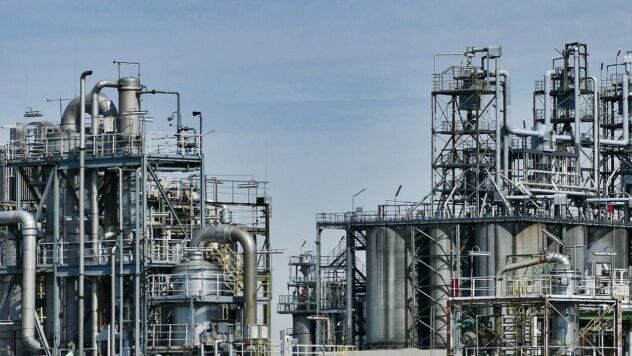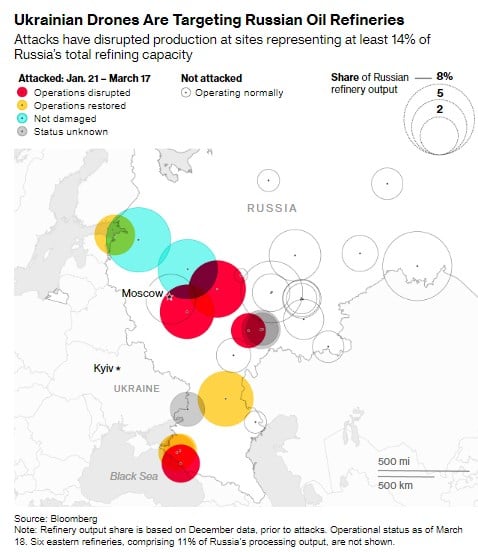
Ukraine’s struggle against Russia has entered a new phase. Ukrainian drones hit Russian oil facilities at a depth of up to 2 thousand kilometers.
This is reported by Blomberg.
It is indicated that at least nine large Russian oil refineries have been successfully attacked this year. According to some estimates, 11% of the total power of the aggressor country has been stopped at the moment.
Now watching
— As the conflict on the front line has shifted in Moscow's favor, the drone campaign is becoming a key element of Ukraine's defense — both in symbolism and strategic goals, — indicates agency.
Such strikes give Kiev the opportunity to penetrate deep into Russian territory and damage industries critical to the Kremlin's war effort, providing both fuel supplies to occupying forces and a flow of petrodollars.
At the same time, while the drone campaign has been a success story for the Ukrainian army, it is a potential wild card for global markets and Kyiv's Western allies. International oil prices have been rising steadily in recent days amid fears that the attacks, which have caused significant damage so far, could one day destroy a major export facility.
Impact of attacks on oil refineries on the Russian Federation
By mid-February, drone attacks had damaged five oil refineries. Immediately after this, Russia banned gasoline exports for six months to ensure sufficient domestic supplies ahead of the seasonal rise in demand.
— Ukrainian leaders seem to feel that even if they remain on the defensive, they must be able to continue to hurt Russia, — said Peter Schroeder, former senior Russia analyst at the US CIA.
What began as a largely symbolic effort, notably last year's drone attack on the Kremlin, has turned into a “concerted campaign to harm a strategic target”, he said.

Bloomberg
How Ukraine managed to produce attack drones
That success didn't come easy, according to drone makers who spoke to Bloomberg. The UAVs had to be designed to overcome sophisticated Russian jamming capabilities using terrain navigation or visual positioning, which does not require any electronic communications after launch.
In addition, they need to operate at a distance of up to 1000 kilometers, and also carry an explosive payload large enough to cause significant damage to objects that were built to be resilient.
Second wave
The Ukrainian drone campaign shows that Kiev is not limited solely to the front line, but also carries out its missions at sea and deep behind enemy lines, SBU head Vasily Malyuk told Bloomberg on March 12.
That same day, a second wave of drone attacks began, damaging some of Russia's largest oil refineries — NORSI in Nizhny Novgorod and Ryazan near Moscow. Despite several attempts, the drone was unable to strike the Surgutneftegaz oil refinery in Kirishi, a key facility on the Baltic Sea coast that produces fuel primarily for export.
How will shocks affect prices
The flurry of attacks caused a jump in prices for gasoline and diesel fuel on the St. Petersburg Commodity and Raw Materials Exchange, although the cost of fuel at gas stations in Russia has changed little.
The Russian Federation may have to redirect more crude oil for export due to the impact on the rate of its refining, said First Deputy Minister of Energy of the Russian Federation Pavel Sorokin.
Outside Russia, the oil market has shown only a modest response to drone attacks, despite the country's status as a major exporter.
That could change if Ukrainian drones succeed in knocking out Kirishi, potentially shutting down production of about 150,000 barrels a day of diesel fuel, destined mainly for export. Oil markets could become even more agitated if Kyiv begins to target Russia's main oil export terminals in the Baltic or Black Seas.
— If Ukraine wanted to increase its pressure on Russia's oil refining revenues, it would target key export terminal infrastructure at the ports of Primorsk or Novorossiysk. However, this will lead to further pressure on relations with Western allies, since the impact on world prices for oil and petroleum products will be significant, — said Mark Williams, research director at consultancy Wood Mackenzie Ltd.
For now, the Ukrainian drone campaign is focused solely on the economic impact on Russia — hampering the country's ability to refine crude oil into fuel and deteriorating its air defenses.
Use of drones in war
UAV attacks — this is, in fact, a new form of war of attrition, when these systems are deployed in huge volumes against strategic targets, said Serra-Martins of the US company Terminal Autonomy.
— The drones are designed to be inexpensive and expendable, meaning missiles from Russian air defense systems can cost 40 times more than the aircraft they target. Even if the drones are shot down, it is still an economic gain — he said.
The attacks also have a psychological purpose, said another drone maker who requested anonymity. Moscow's propaganda tries to make its citizens forget that the nation is at war, but long lines at gas stations will bring the reality of the conflict into their daily lives.
Drones are becoming an increasingly important element in Ukraine's military strategy, but they cannot replace modern NATO weapons, said several prominent businessmen who help finance their purchase.
Kyiv is forced to rely on these unmanned vehicles because its allies are unwilling to provide long-range missiles capable of destroying targets deep inside Russia for fear of escalation.
In addition, the months-long Congressional delay of US$60 billion in US military aid has left Ukraine increasingly short of even basic munitions such as artillery shells.
— The campaign against Russian energy infrastructure shows that Kyiv can continue to cause some pain. But it is unlikely that this will have a strategic impact on the course of the war, — said Schroeder, a former CIA analyst who is now an assistant senior fellow at the Center for a New American Security in Washington.
How the UAV campaign will develop next
More than two years after Russia's invasion of Ukraine, with military setbacks on the front lines and wavering support from Western allies, the success of Ukrainian attacks on oil refineries suggests the drone campaign will continue.
— These weeks have demonstrated to many that the Russian military machine has vulnerabilities that we can reach with our weapons. Ukraine will now always have a strike force in the sky, — said President Vladimir Zelensky on March 16.
With each month of this year, the armed forces of Kyiv will have more and more drones that will operate on Russian territory, said Minister of Digital Transformation Mikhail Fedorov.
— This will be an unprecedented number of long-range drones, — he noted.
Attacks on oil refineries in Russia
On the night of March 13, drones attacked three oil refineries at once — in Ryazan, Kstovo (Nizhny Novgorod region) and Kirishi (Leningrad region).
Bloomberg wrote that attacks on oil refineries in Russia paralyzed 12% of the aggressor country’s oil refining capacity.

